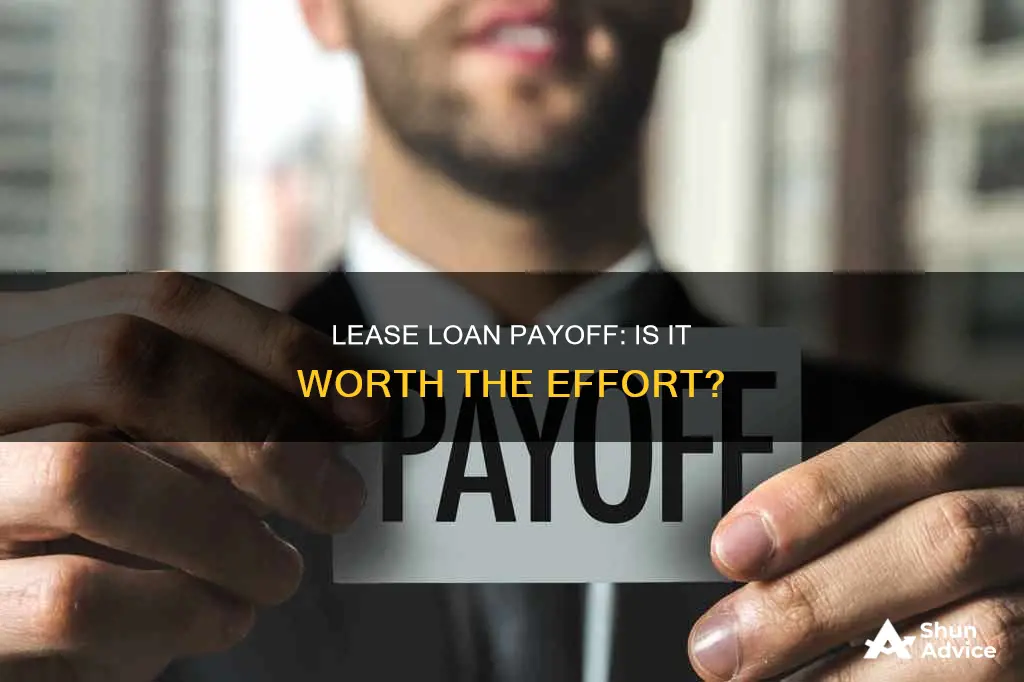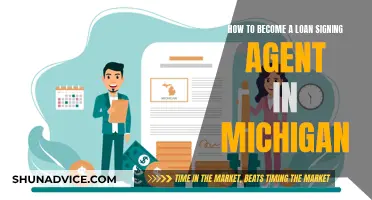
Loan/lease payoff coverage, also known as gap insurance, is an optional coverage that can help protect you financially in the event of a total vehicle loss. If your vehicle is totaled, the insurance company will typically pay you the actual cash value (ACV) of the vehicle. However, if you owe more on your auto loan or lease than the vehicle is worth, you’ll still be responsible for the difference. Loan/lease payoff coverage bridges this gap, paying the difference between the ACV and the amount you owe on the vehicle.
| Characteristics | Values |
|---|---|
| What is loan/lease payoff coverage? | A type of insurance that can help protect you financially in the event of a total vehicle loss. |
| Who is it for? | People who are making payments on or leasing their car, and those who owe more on their loan than the car is worth. |
| When is it unnecessary? | When you fully own your car or are confident that it is worth more than your remaining loan balance. |
| How does it work? | If your vehicle is totaled, the insurance company will pay you the actual cash value (ACV) of the vehicle. Loan/lease payoff coverage pays the difference between the ACV and the amount you owe on the vehicle. |
| How is it different from gap insurance? | Gap insurance typically covers deductibles and pays the difference between the loan balance and the ACV. Loan/lease coverage doesn't cover deductibles and usually pays only up to 25% of the ACV. |
| How much does gap insurance cost? | The cost depends on factors such as the MSRP, loan term, APR, insurance provider, and your credit score. Gap insurance can be added to your policy for an additional $25-$50 per year. |
What You'll Learn

Gap insurance vs. loan/lease payoff coverage
When purchasing a new vehicle, it is important to consider the financial implications if your car gets damaged or stolen. Gap insurance and loan/lease payoff coverage are two options that can help protect you financially in such situations.
Gap Insurance
Gap insurance covers the difference between what your car insurance pays if your vehicle is stolen or totalled and what you still owe on your loan or lease. This type of insurance is typically offered for new cars and must be purchased within a short time frame, usually within 30 days of purchase. It covers deductibles and pays the difference between the car's actual cash value (ACV) and the loan balance. Gap insurance is often required by lenders for leased vehicles and when the down payment is less than 20% of the sale price. It is also useful for longer financing terms, as it can help prevent a financial shortfall if your vehicle is totalled. Many lease agreements include gap insurance automatically, while others require an extra payment.
Loan/Lease Payoff Coverage
Loan/lease payoff coverage, on the other hand, is more flexible and can be purchased at any time. It helps if your vehicle is totalled while you're still making payments on your loan or lease. However, the payout is limited to a percentage of the car's ACV, typically 25%. Loan/lease payoff coverage does not cover deductibles, and the exact limit varies by state. This type of coverage is ideal for used cars, as gap insurance is usually not offered for them. It is important to note that some institutions may require loan/lease payoff coverage as part of your loan or lease terms.
In summary, both gap insurance and loan/lease payoff coverage can provide financial protection in the event of a total loss or theft of your vehicle. Gap insurance tends to offer more comprehensive coverage, while loan/lease payoff coverage is more flexible and can be purchased at any time. The decision between the two depends on factors such as the age of your car, the terms of your loan or lease, and the level of financial protection you require.
Refinancing a Boat Loan: Steps to Navigate Interest Rates
You may want to see also

When is loan/lease payoff coverage worth it?
Loan/lease payoff coverage, also known as gap insurance, is an optional coverage that can help protect you financially in the event of a total vehicle loss. If your vehicle is totalled, the insurance company will typically pay you the actual cash value (ACV) of the vehicle. However, if the ACV is less than what you owe on your loan or lease, you will be responsible for the difference. This is where loan/lease payoff coverage comes in, as it pays off that remaining balance.
Now, is loan/lease payoff coverage worth it? Well, that depends on your specific situation. Here are some scenarios where it might be beneficial:
- New Car Owners: If you've recently purchased a new car, especially a leased vehicle, loan/lease payoff coverage can be advantageous. New cars depreciate quickly, and if your car is totalled shortly after purchase, the ACV may be significantly lower than what you owe on your loan or lease.
- Drivers with High Loan Balances: If you have a significant loan balance on your vehicle, loan/lease payoff coverage can provide financial protection. In this case, the coverage can help bridge the gap between the ACV and your outstanding loan balance.
- Longer Loan Terms: If you have a longer loan term, such as 60 months or more, your car may depreciate faster than you can pay it off. In this case, loan/lease payoff coverage can help protect you from owing more than your car's value.
- Higher Mileage: Higher mileage can accelerate depreciation, increasing the risk of owing more than your car's worth. Loan/lease payoff coverage can help mitigate this risk.
- Lease Requirements: Some lease agreements may require loan/lease payoff coverage to protect the leasing company's investment. In this case, it is necessary to have this coverage.
However, it's important to note that loan/lease payoff coverage may not be worth it in certain situations. For example, if you own your car outright or if the value of your car is higher than your remaining loan balance, you may not need this additional coverage. Additionally, you should consider the cost of the coverage and whether it aligns with your budget.
It's always a good idea to consult with a licensed insurance agent or your insurance provider to determine if loan/lease payoff coverage is right for you and to understand the specific terms and conditions of the coverage.
The True Cost of Capital: Which Financing Option Costs Most?
You may want to see also

When is gap insurance worth it?
Gap insurance is worth considering when there is a significant difference between your car's value and the amount you owe on it. This can happen when:
- You are leasing your car
- You made a lower down payment on a new car (less than 20% of the sale price)
- You have a longer financing term for your vehicle
- You want to protect yourself against depreciation
- You have a loan rollover
- You have rolled over negative equity from a previous loan
Gap insurance covers the difference between what your car insurance pays if your vehicle is stolen or totalled and what you still owe on your loan or lease. This is important because insurers typically reimburse based on the actual cash value (ACV) of the car, which can be much lower than the remaining loan balance.
Loan/lease payoff coverage is similar to gap insurance but is more limited in its payout. It can be purchased at any time and covers up to 25% of the ACV of your vehicle. Gap insurance, on the other hand, must be purchased within a short time frame (often within 30 days of purchase) and covers the entire difference between what you owe and the ACV of your claim settlement.
In summary, gap insurance is worth it when there is a significant difference between your car's value and the loan amount, especially when leasing a car or making a smaller down payment. It protects you from owing more than your car is worth and covers any shortfall.
Exploring the Intriguing Space In Between
You may want to see also

How much does gap insurance cost?
The cost of GAP insurance depends on the underwriter. Dealerships and lenders charge higher prices for GAP insurance than car insurance companies. Lenders and dealerships sell GAP insurance for a flat rate, typically between $500 and $700, which are the highest rates for this type of policy. Plus, you will pay interest on the sum since it will be rolled into your loan. Insurance companies, on the other hand, charge an average of $20 to $40 per year for GAP insurance when buyers bundle it into an existing insurance policy. Doing so only increases your comprehensive and collision insurance cost by about five to six percent on average, which makes it a lot more affordable. If you want to buy a standalone GAP insurance policy, you can expect to pay between $200 and $300.
GAP insurance, or General Asset Protection insurance, covers the difference between a car's worth and the balance the owner owes on its lease or car loan if the vehicle is stolen or can't be repaired after an accident. This is a benefit you can't get from standard collision and comprehensive insurance policies. GAP insurance acts as a financial safety net for drivers who finance or lease a vehicle.
In most cases, if you paid for GAP insurance upfront and later sold the car, the provider will refund the unused portion of the policy. When buying GAP insurance, it pays to shop around and compare carriers and quotes carefully. You may end up paying less than expected based on your age, gender, vehicle type, and other factors.
GAP insurance in New York costs an average of $2 to $30 per month, depending on whether you buy it from a dealership, a car manufacturer, or your insurance provider. GAP insurance is only needed for one to three years, or until your vehicle is worth more than you still owe on your loan or lease.
Title Loans: World Finance's Offerings and Your Options
You may want to see also

How to determine the right coverage for you
Loan/lease payoff coverage, also known as gap insurance, is an optional coverage that can help protect you financially in the event of a total vehicle loss. If your car is fully owned by you or if you are confident that it is worth more than your remaining loan balance, there may be no need for you to consider getting loan/lease payoff coverage.
To determine the right coverage for you, consider the following:
- The cost of gap insurance depends on several factors, including the MSRP, loan term, amount financed, APR, insurance provider, your credit score, and the value of your vehicle.
- Gap insurance is typically more affordable when purchased through an insurance company than through a dealership.
- Some lenders may offer optional gap coverage as part of your auto loan or lease. It is important to consult with your insurance agent or a licensed agent to determine if gap insurance is right for you.
- To determine the amount of gap insurance you need, subtract your vehicle's current Actual Cash Value (ACV) from your remaining loan balance. The difference is the amount of coverage you'll need.
- Maintaining comprehensive and collision coverage is typically required to purchase gap insurance.
- Gap insurance is not necessary for everyone. If you paid for your car in full or owe less than what your car is worth, you don't need it.
- Once your loan balance drops below your car's value, you can drop the coverage as it won't provide additional benefits at that point.
Becoming a Loan Broker: Steps to Success
You may want to see also
Frequently asked questions
Loan/lease payoff coverage, also known as gap insurance, is an optional form of insurance that can help protect you financially in the event of a total vehicle loss.
If your vehicle is totaled, the insurance company will typically pay you the actual cash value (ACV) of the vehicle. If you owe more on your auto loan or lease than the vehicle is worth, you’ll still be responsible for the difference. Loan/lease payoff coverage bridges this gap, paying the difference between the ACV and the amount you owe on the vehicle.
Loan/lease payoff coverage is worth it if you owe more on your loan than the car is worth. It is also worth considering if you have a significant loan balance on your vehicle, as it can provide financial protection.
Loan/lease payoff coverage is not worth it if your car is fully owned by you or if you are confident that it is worth more than your remaining loan balance. It may also not be worth it if you paid for your car in full or owe less than what your car is worth.
The cost of loan/lease payoff coverage depends on several factors, including the make and model of your vehicle, the insurance provider, and your credit score. Gap insurance can typically be added to your auto insurance policy for an additional $25-$50 per year.







